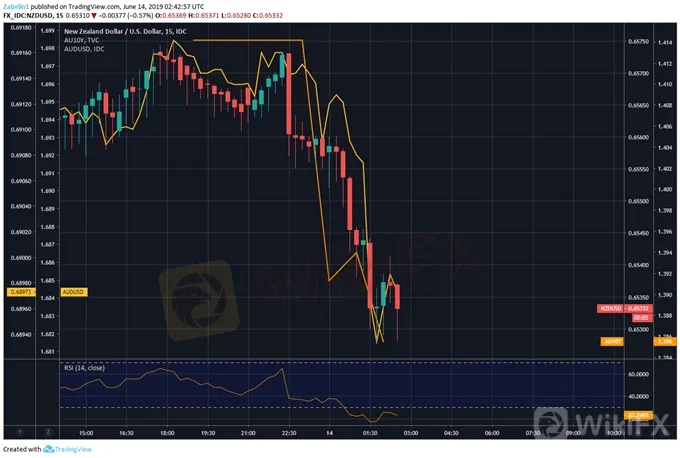简体中文
繁體中文
English
Pусский
日本語
ภาษาไทย
Tiếng Việt
Bahasa Indonesia
Español
हिन्दी
Filippiiniläinen
Français
Deutsch
Português
Türkçe
한국어
العربية
NZDUSD, AUDUSD Tumble to Support. RBNZ, RBA Rate Cut Bets Deepen
Abstract:The NZDUSD and AUDUSD are tumbling to support as increasingly dovish RBNZ and RBA monetary policy bets are undermining their appeal, boosting the Japanese Yen as carry trades unwind.
AUDUSD, NZD/USD, RBA, RBNZ Talking Points
Australian and New Zealand Dollars sinking with dovish RBA, RBNZ bets
Anti-risk Japanese Yen is rising, likely due to an unwinding of carry trade
NZDUSD fall could extend, perhaps reaching 0.6425 after clearing support
Trade all the major global economic data live as it populates in the economic calendar and follow the live coverage for key events listed in theDailyFX Webinars. Wed love to have you along.
The pro-risk Australian and New Zealand Dollars are aiming lower in morning Friday trade as the anti-risk Japanese Yen gains. At first glance, this appears to be a case of general risk aversion, but stocks are aiming cautiously higher looking at APAC equities. Furthermore, S&P 500 futures are pointing to the upside heading into European and US trading hours.
NZD‘s decline with local front-end government bond yields was initiated by dismal New Zealand Manufacturing PMI below. Growth clocked in at a snail’s pace, just 50.2 in May versus 53.0 prior. That was the softest pace of expansion since December 2012 and follows a steady slowdown since the beginning of this year. This underscored action taken by the RBNZ to cut rates back in May as inflation slowed.
Hours later, both the AUD and NZD extended losses as the National Australia Bank (NAB) and Royal Bank of Canada in Sydney envisioned the RBA cutting rates further in the near-term. The former sees rates at 0.75% by November. The latter sees them at 0.5% by May 2020. Overnight index swaps are now pricing in a greater than 60% chance of a cut from the Reserve Bank of Australia next month.
Gains in the Japanese Yen might have had more to do with an unwinding of carry positions due to increasingly dovish shift in monetary policy expectations, rather than a selloff in stocks. In fact, earlier in the day, results in US government bond auctions indicated strong demand for haven assets as yields fell, perhaps amid rising fears of a recession. This is undermining the appeal of the relatively high-yielding AUD and NZD. Meanwhile, the US Dollar could benefit the most if a premium is placed on liquidity.
NZDUSD, AUDUSD, Australian Bond Yields 15-Minute Chart

Chart Created by Dimitri Zabelin
NZDUSD Technical Analysis
Taking a closer at NZDUSD, the pair has been resuming the dominant downtrend that took it from a peak of 0.6940 back in March, to lows set in May above 0.6482. If the appeal of the pro-risk AUD and NZD continues to deteriorate, Kiwi Dollar may be very well looking to not only breach current 2019 lows, but also then extend declines to eventually testing 0.6425.
NZDUSD Daily Chart

Chart Created in TradingView
Disclaimer:
The views in this article only represent the author's personal views, and do not constitute investment advice on this platform. This platform does not guarantee the accuracy, completeness and timeliness of the information in the article, and will not be liable for any loss caused by the use of or reliance on the information in the article.
Read more

KVB Market Analysis | 28 August: Yen Strengthens on BoJ Rate Hike Hints; USD/JPY Faces Uncertainty
The Japanese Yen rose 0.7% against the US Dollar after BoJ Governor Kazuo Ueda hinted at potential rate hikes. This coincided with a recovery in Asian markets, aided by stronger Chinese stocks. With the July FOMC minutes already pointing to a September rate cut, the US Dollar might edge higher into the weekend.

KVB Market Analysis | 27 August: AUD/USD Holds Below Seven-Month High Amid Divergent Central Bank Policies
The Australian Dollar (AUD) traded sideways against the US Dollar (USD) on Tuesday, staying just below the seven-month high of 0.6798 reached on Monday. The downside for the AUD/USD pair is expected to be limited due to differing policy outlooks between the Reserve Bank of Australia (RBA) and the US Federal Reserve. The RBA Minutes indicated that a rate cut is unlikely soon, and Governor Michele Bullock affirmed the central bank's readiness to raise rates again if necessary to combat inflation.

KVB Market Analysis | 23 August: JPY Gains Ground Against USD as BoJ Signals Possible Rate Hike
JPY strengthened against the USD, pushing USD/JPY near 145.00, driven by strong inflation data and BoJ rate hike expectations. Japan's strong Q2 GDP growth added support. However, USD gains may be limited by expectations of a Fed rate cut in September.

KVB Market Analysis | 22 August: Gold Stays Strong Above $2,500 as Fed Rate Cut Hints Loom
Gold prices remain above $2,500, near record highs, as investors await the Federal Open Market Committee minutes for confirmation of a potential Fed rate cut in September. The Fed's dovish shift, prioritizing employment over inflation, has weakened the US Dollar, boosting gold. A recent revision showing the US created 818,000 fewer jobs than initially reported also strengthens the case for a rate cut.
WikiFX Broker
Latest News
Japan to Take Action to Stabilize the Yen
Ringgit Remains Flat Amid Holidays, US Debt Concerns Loom
Taurex: Is it Safe to Invest?
WikiEXPO Global Expert Interview: Loretta Joseph——Unlock the forefront of digital finance
Vietnamese Police Bust $1.2 Million Crypto Fraud Case
XTB Receives Licenses to Operate in Indonesia & UAE
SEBI Bans Big "Finfluencers for Misleading Investors"
WikiFX New Year Bash: Chance to Win 70 USDT
Malaysia’s Securities Commission Enforces Ban on Bybit & Its CEO
WikiFX Review: Is HYCM still reliable in 2024?
Currency Calculator






